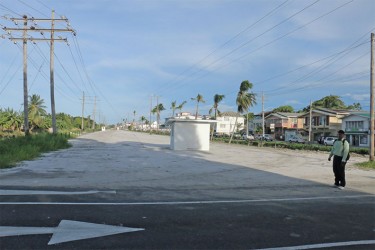Bai Shan Lin’s parking lot constructed along the Lamaha Street embankment is ready for use by the Guyana Revenue Authority (GRA) but the head of the agency, Khurshid Sattaur has remained mum on the development and continuing questions about the propriety of the arrangement in light of recent controversies surrounding the Chinese company.
Sattaur last week refused to answer questions from Stabroek News in relation to the construction of the parking lot which has received constant scrutiny considering the nature of the deal between the autonomous tax collecting body and the private company.
Numerous questions were recently raised about the extent of Bai Shan Lin’s logging and duty-free concessions. Observers have also raised questions about the terms of its investment contract and its tax obligations therein.
The construction of the parking lot has long been clouded by issues surrounding the propriety of the project and given the recent furore involving Bai Shan Lin’s logging exports, observers are questioning why the GRA has remained silent.
Stabroek News spoke with Sattaur briefly on Wednesday and he repeatedly said that he had no comment and was not aware of any issues surrounding Bai Shan Lin’s involvement in the construction of the parking lot. Sattaur told Stabroek News that the business should be left alone and that the media was “hounding” the business’ various ventures and “calling the people them not civic-minded.”

He continued that in circumstances where Bai Shan Lin was operating in a “civic-minded manner” the media was “tearing” them apart. When Stabroek News asked what was the extent of involvement between the GRA and Bai Shan Lin in the parking lot venture, Sattaur stated that he knew nothing and had no comment and told this publication to speak to the Alphonso Group and the Finance Ministry who also utilise land along the embankment for parking. Stabroek News pressed Sattaur on the concerns over the propriety of the arrangement considering that the GRA is an autonomous body charged with ensuring the tax compliance of businesses including foreign firms operating in Guyana such as Bai Shan Lin.
Last October, Sattaur had defended the arrangement with the Chinese firm for the construction of the car park on the Lamaha Street embankment. He had stated that the Chinese firm had “seized the opportunity to demonstrate its corporate social responsibility” by building a parking area on the portion of the reserve granted to the GRA by the government. It was revealed that the GRA would also be paying a fee to Bai Shan Lin, which sparked questions as to how the Chinese firm had come about being the builder for the site and if the deal was above board why it had not been tendered out. To date the total cost of the investment has not been released by the Chinese firm nor has the rent to be paid by the GRA for use of the facility been made public.
Sattaur had pointed out in October that the organisation’s Camp Street headquarters housed eight hundred and forty one staff of whom approximately two hundred and thirty five require parking. Further, around 1,000 taxpayers frequent the office on a daily basis of whom it is estimated that approximately three hundred have vehicles. He said this means that over five hundred persons would require parking on a daily basis. He said these persons currently compete with schools and other businesses in the area for the available sidewalk.
Critics have also raised concerns over the usefulness of a parking facility so far from the GRA offices on Camp Street.
The Guyana Human Rights Association in November of last year was one of the most vocal critics of the arrangement. The association questioned “what, in the first place, possessed the GRA to rent an apartment building (the Camp Street head office) reportedly for some G$10M per month that also required G$227M to convert into an office block and has no parking space. Given that the building was rented from the NIS, which inherited it as a result of what proved to be reckless investment in the failed Trinidadian financial conglomerate Clico, the answer to that question would seem to involve further murkiness.”
GHRA asserted that “rather than cozying up to companies of this nature, the GRA should be keeping them at arm’s length and under strict surveillance”. The association noted that parking concerns could never had been an oversight on the part of the GRA considering they would have known the building they would be utilizing so “it is clear that the GRA were benefitting in some shape or form from BSL (Bai Shan Lin) in a manner that went beyond a normal commercial arrangement…References to being ‘good corporate citizens’ and ‘giving back for the benefits they received for their investments’ all point in this direction”.




